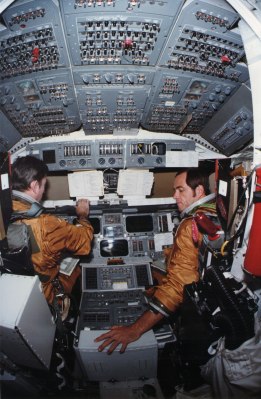For those who grew up watching the endless coverage of the Apollo program in the 60s and 70s, the sight of OV-102, better known as the Space Shuttle Columbia, perched on pad 39A at the Kennedy Space Center was somewhat disconcerting. Compared to the sleek lines of a Saturn V rocket, the spacecraft on display on April 12, 1981, seemed an ungainly beast. It looked like an airplane that had been tacked onto a grain silo, with a couple of roman candles attached to it for good measure. Everything about it seemed the opposite of what we’d come to expect from spaceflight, but as the seconds ticked away to liftoff 40 years ago this day, we still had hope that this strange contraption wouldn’t disappoint.
At first, as the main engines ignited, it seemed that Columbia would indeed disappoint. The liquid hydrogen exhaust plume seemed anemic, at least compared to the gout of incandescent kerosene that had belched out from every rocket I’d ever seen launched. But then those magnificent — and as it later turned out, deadly dangerous — solid rocket boosters came to life, and Columbia fairly leaped off the launchpad. Americans were on their way to space again after a six-year absence, and I remember cheering astronauts John Young and Bob Crippen on as I watched the coverage with my dad that early Sunday morning.
STS-1

The seeds for what would become the Space Transportation System (STS), which was the official name for the Space Shuttle program, were sown even before the famous flight of Apollo 11 in 1969. The incredible expense of launching an almost completely expendable rocket to get astronauts into orbit or beyond was becoming untenable, so the focus switched to building a new generation of spacecraft with reusability in mind. Dozens of ideas were floated, but eventually the rocket-boosted spaceplane concept won out and the STS program was funded by Congress in 1972.
The first flight of Columbia on that April morning, which by sheer luck coincided with the 20th anniversary of Yuri Gagarin’s ride to space aboard Vostok-1, was a record-setter in many ways. Not only was it to be the first orbital flight of a reusable spaceplane, but it was also the first time America had a crewed maiden flight. Every rocket used for crewed missions to that point had had at least one uncrewed flight. Columbia had been tested on the pad with her main engines lit, and sister ship Enterprise had done extensive unpowered drop tests for approach and landing training, but everything between the countdown clock reaching zero and the end of reentry had never been done before.
STS-1 was a brief mission filled with technical tests; it was intended to make sure the orbiter was spaceworthy and did very little if any science. Young and Crippen stayed aloft for a little more than two days before deorbiting over the Indian Ocean, beginning the unpowered, Mach 24 reentry process. Much of the early reentry maneuvers were handled automatically by Columbia’s on-board computers, but Commander Young eventually took the stick and guided the spaceplane to a smooth landing on the dry lake beds of Edwards Air Force Base in California. STS-1 was complete, and the age of the Space Shuttle had begun.
Columbia’s Legacy
As with any major system, the design of the Shuttle was a compromise, but given its high profile as a successor to Apollo and the competing factions vying for the capabilities it wanted to see in a launch system, it’s a wonder the spacecraft ever got off the ground. Along with the test article Enterprise, the five STS orbiters — Columbia, Challenger, Discovery, Atlantis, and Endeavour — have been called the most complex machines ever built by humans. The truth of that is probably open to debate, but there’s no doubt that the complexity of the orbiters was at odds with its reusability, and the desired quick turnaround times from each orbital mission were never delivered.
Still, the Shuttle fleet delivered a total of 133 successful missions, ferried 355 individuals to space, and delivered thousands of tons of payloads into orbit and beyond. The Hubble Space Telescope, both its initial delivery and later repairs, were courtesy of the Shuttle, and a great many of the modules of the ISS were delivered in the orbiter’s ample cargo bay. The interplanetary missions that started in the payload bay of orbiters — notably Magellan, Galileo, and Ulysses — are still paying dividends in terms of understanding the nature of the universe.
Still, the Space Shuttle program suffered from a pair of catastrophic losses. As much as I remember the launch of STS-1, I much more keenly remember the loss of Challenger at launch on STS-51-L in 1986, and the reentry breakup of Columbia on STS-107 in 2003. Those losses plus the failure to deliver the rapid turnaround and lower costs needed to maintain a reasonable tempo of launches were the final nails in the coffin for the STS program, which was canceled after the 2011 landing of STS-135. Still, the program had staying power, and for 30 years it was the only way for America to get payloads upstairs.
Article From & Read More ( Space Shuttle Program: 40th Anniversary Of The First Launch Of Columbia - Hackaday )https://ift.tt/327eepr
Science
No comments:
Post a Comment